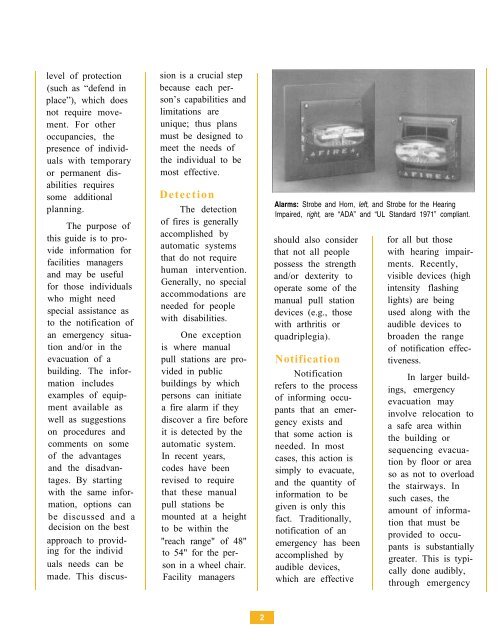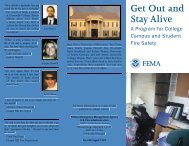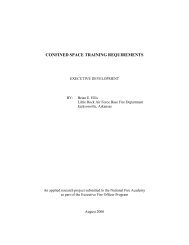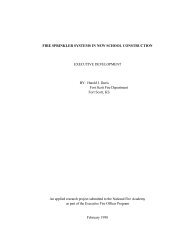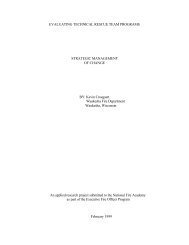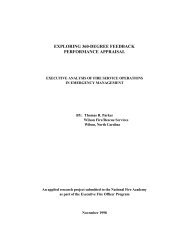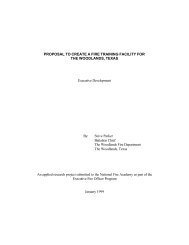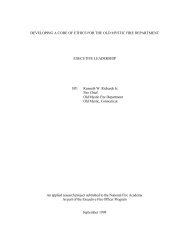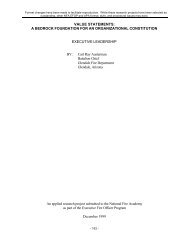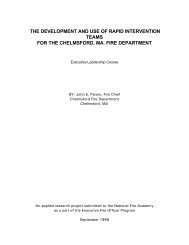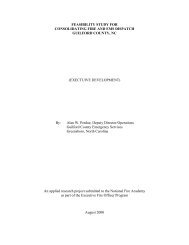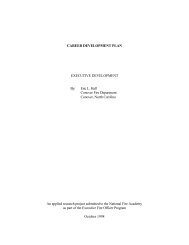Emergency Procedures for Employees with Disabilities - US Fire ...
Emergency Procedures for Employees with Disabilities - US Fire ...
Emergency Procedures for Employees with Disabilities - US Fire ...
You also want an ePaper? Increase the reach of your titles
YUMPU automatically turns print PDFs into web optimized ePapers that Google loves.
level of protection<br />
(such as “defend in<br />
place”), which does<br />
not require movement.<br />
For other<br />
occupancies, the<br />
presence of individuals<br />
<strong>with</strong> temporary<br />
or permanent disabilities<br />
requires<br />
some additional<br />
planning.<br />
The purpose of<br />
this guide is to provide<br />
in<strong>for</strong>mation <strong>for</strong><br />
facilities managers<br />
and may be useful<br />
<strong>for</strong> those individuals<br />
who might need<br />
special assistance as<br />
to the notification of<br />
an emergency situation<br />
and/or in the<br />
evacuation of a<br />
building. The in<strong>for</strong>mation<br />
includes<br />
examples of equipment<br />
available as<br />
well as suggestions<br />
on procedures and<br />
comments on some<br />
of the advantages<br />
and the disadvantages.<br />
By starting<br />
<strong>with</strong> the same in<strong>for</strong>mation,<br />
options can<br />
be discussed and a<br />
decision on the best<br />
approach to providing<br />
<strong>for</strong> the individ<br />
uals needs can be<br />
made. This discus-<br />
sion is a crucial step<br />
because each person’s<br />
capabilities and<br />
limitations are<br />
unique; thus plans<br />
must be designed to<br />
meet the needs of<br />
the individual to be<br />
most effective.<br />
Detection<br />
The detection<br />
of fires is generally<br />
accomplished by<br />
automatic systems<br />
that do not require<br />
human intervention.<br />
Generally, no special<br />
accommodations are<br />
needed <strong>for</strong> people<br />
<strong>with</strong> disabilities.<br />
One exception<br />
is where manual<br />
pull stations are provided<br />
in public<br />
buildings by which<br />
persons can initiate<br />
a fire alarm if they<br />
discover a fire be<strong>for</strong>e<br />
it is detected by the<br />
automatic system.<br />
In recent years,<br />
codes have been<br />
revised to require<br />
that these manual<br />
pull stations be<br />
mounted at a height<br />
to be <strong>with</strong>in the<br />
"reach range" of 48"<br />
to 54" <strong>for</strong> the person<br />
in a wheel chair.<br />
Facility managers<br />
2<br />
Alarms: Strobe and Horn, left, and Strobe <strong>for</strong> the Hearing<br />
Impaired, right, are “ADA” and “UL Standard 1971” compliant.<br />
should also consider<br />
that not all people<br />
possess the strength<br />
and/or dexterity to<br />
operate some of the<br />
manual pull station<br />
devices (e.g., those<br />
<strong>with</strong> arthritis or<br />
quadriplegia).<br />
Notification<br />
Notification<br />
refers to the process<br />
of in<strong>for</strong>ming occupants<br />
that an emergency<br />
exists and<br />
that some action is<br />
needed. In most<br />
cases, this action is<br />
simply to evacuate,<br />
and the quantity of<br />
in<strong>for</strong>mation to be<br />
given is only this<br />
fact. Traditionally,<br />
notification of an<br />
emergency has been<br />
accomplished by<br />
audible devices,<br />
which are effective<br />
<strong>for</strong> all but those<br />
<strong>with</strong> hearing impairments.<br />
Recently,<br />
visible devices (high<br />
intensity flashing<br />
lights) are being<br />
used along <strong>with</strong> the<br />
audible devices to<br />
broaden the range<br />
of notification effectiveness.<br />
In larger buildings,<br />
emergency<br />
evacuation may<br />
involve relocation to<br />
a safe area <strong>with</strong>in<br />
the building or<br />
sequencing evacuation<br />
by floor or area<br />
so as not to overload<br />
the stairways. In<br />
such cases, the<br />
amount of in<strong>for</strong>mation<br />
that must be<br />
provided to occupants<br />
is substantially<br />
greater. This is typically<br />
done audibly,<br />
through emergency


